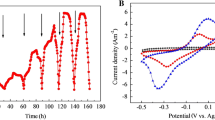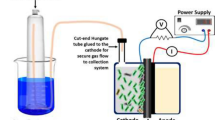Abstract
The large cost of components used in microbial electrolysis cell (MEC) reactors represents an important limitation that is delaying the commercial implementation of this technology. In this work, we explore the feasibility of using pyrolysed almond shells (PAS) as a material for producing low-cost anodes for use in MEC systems. This was done by comparing the microbial populations that developed on the surface of PAS bioanodes with those present on the carbon felt (CF) bioanodes traditionally used in MECs. Raw almond shells were pyrolysed at three different temperatures, obtaining the best conductive material at the highest temperature (1000 °C). The behaviour of this material was then verified using a single-chamber cell. Subsequently, the main test was carried out using two-chamber cells and the microbial populations extant on each of the bioanodes were analysed. High-throughput sequencing of the 16S rRNA gene for eubacterial populations was carried out in order to compare the microbial communities attached to each type of electrode. The microbial populations on each electrode were also quantified by real-time polymerase chain reaction (real-time PCR) to determine the amount of bacteria capable of growing on the electrodes’ surface. The results indicated that the newly developed PAS bioanodes possess a biofilm similar to those found on the surface of traditional CF electrodes.








Similar content being viewed by others
References
Escapa A, Mateos R, Martínez EJ, Blanes J (2016) Microbial electrolysis cells: an emerging technology for wastewater treatment and energy recovery. From laboratory to pilot plant and beyond. Renew Sust Energ Rev 55:942–956. https://doi.org/10.1016/j.rser.2015.11.029
Hegab HM, ElMekawy A, van den Akker B et al (2018) Innovative graphene microbial platforms for domestic wastewater treatment. Rev Environ Sci Biotechnol 17:147–158. https://doi.org/10.1007/s11157-018-9459-0
Sonawane JM, Yadav A, Ghosh PC, Adeloju SB (2017) Recent advances in the development and utilization of modern anode materials for high performance microbial fuel cells. Biosens Bioelectron 90:558–576. https://doi.org/10.1016/J.BIOS.2016.10.014
Zhang J, Li J, Ye D et al (2014) Tubular bamboo charcoal for anode in microbial fuel cells. J Power Sources 272:277–282. https://doi.org/10.1016/j.jpowsour.2014.08.115
Thambidurai A, Lourdusamy JK, John JV, Ganesan S (2014) Preparation and electrochemical behaviour of biomass based porous carbons as electrodes for supercapacitors - a comparative investigation. Korean J Chem Eng 31:268–275. https://doi.org/10.1007/s11814-013-0228-z
Mohanakrishna G, Kalathil S, Pant D (2017) Reactor design for bioelectrochemical systems. In: Microbial fuel cell: a bioelectrochemical system that converts waste to Watts. Springer International Publishing, New York, pp 209–227
Rozendal RA, Hamelers HVM, Rabaey K, Keller J, Buisman CJ (2008) Towards practical implementation of bioelectrochemical wastewater treatment. Trends Biotechnol 26:450–459. https://doi.org/10.1016/J.TIBTECH.2008.04.008
Maksimova YG (2019) Microorganisms and carbon nanotubes: interaction and applications (review). Appl Biochem Microbiol 55:1–12. https://doi.org/10.1134/S0003683819010101
Pandey G (2019) Biomass based bio-electro fuel cells based on carbon electrodes: an alternative source of renewable energy. SN Appl Sci 1:1–10. https://doi.org/10.1007/s42452-019-0409-4
Chen J, Zhou X, Mei C et al (2017) Evaluating biomass-derived hierarchically porous carbon as the positive electrode material for hybrid Na-ion capacitors. J Power Sources 342:48–55. https://doi.org/10.1016/j.jpowsour.2016.12.034
Momodu D, Madito M, Barzegar F, Bello A, Khaleed A, Olaniyan O, Dangbegnon J, Manyala N (2017) Activated carbon derived from tree bark biomass with promising material properties for supercapacitors. J Solid State Electrochem 21(3):859–872. https://doi.org/10.1007/s10008-016-3432-z
Chen Q, Pu W, Hou H, Hu J, Liu B, Li J, Cheng K, Huang L, Yuan X, Yang C, Yang J (2018) Activated microporous-mesoporous carbon derived from chestnut shell as a sustainable anode material for high performance microbial fuel cells. Bioresour Technol 249:567–573. https://doi.org/10.1016/J.BIORTECH.2017.09.086
Huggins T, Wang H, Kearns J et al (2014) Biochar as a sustainable electrode material for electricity production in microbial fuel cells. Bioresour Technol 157:114–119. https://doi.org/10.1016/j.biortech.2014.01.058
Chen S, He G, Hu X, Xie M, Wang S, Zeng D, Hou H, Schröder U (2012) A three-dimensionally ordered macroporous carbon derived from a natural resource as anode for microbial bioelectrochemical systems. ChemSusChem 5:1059–1063. https://doi.org/10.1002/cssc.201100783
Chen W, Feng H, Shen D, Jia Y, Li N, Ying X, Chen T, Zhou Y, Guo J, Zhou M (2018) Carbon materials derived from waste tires as high-performance anodes in microbial fuel cells. Sci Total Environ 618:804–809
Queirós CSGP, Cardoso S, Lourenço A, Ferreira J, Miranda I, Lourenço MJV, Pereira H (2019) Characterization of walnut, almond, and pine nut shells regarding chemical composition and extract composition. Biomass Convers Biorefinery 10:175–188. https://doi.org/10.1007/s13399-019-00424-2
Aktas T, Thy P, Williams RB et al (2015) Characterization of almond processing residues from the Central Valley of California for thermal conversion. Fuel Process Technol 140:132–147. https://doi.org/10.1016/j.fuproc.2015.08.030
Feng H, Jia Y, Shen D et al (2018) The effect of chemical vapor deposition temperature on the performance of binder-free sewage sludge-derived anodes in microbial fuel cells. Sci Total Environ 635:45–52. https://doi.org/10.1016/j.scitotenv.2018.04.124
Malika A, Jacques N, Fallah Jaafar E et al (2016) Pyrolysis investigation of food wastes by TG-MS-DSC technique. Biomass Convers Biorefinery 6(2):161–172. https://doi.org/10.1007/s13399-015-0171-9
Gupta S, Gupta GK, Mondal MK (2019) Slow pyrolysis of chemically treated walnut shell for valuable products: effect of process parameters and in-depth product analysis. Energy 181:665–676. https://doi.org/10.1016/j.energy.2019.05.214
Moreno R, San-Martín MI, Escapa A, Morán A (2016) Domestic wastewater treatment in parallel with methane production in a microbial electrolysis cell. Renew Energy 93:442–448. https://doi.org/10.1016/j.renene.2016.02.083
Gupta GK, Gupta PK, Mondal MK (2019) Experimental process parameters optimization and in-depth product characterizations for teak sawdust pyrolysis. Waste Manag 87:499–511. https://doi.org/10.1016/j.wasman.2019.02.035
San-Martín MI, Sotres A, Alonso RM, Díaz-Marcos J, Morán A, Escapa A (2019) Assessing anodic microbial populations and membrane ageing in a pilot microbial electrolysis cell. Int J Hydrog Energy 44(32):17304–17315. https://doi.org/10.1016/j.ijhydene.2019.01.287
Li X, Zhao Q, Wang X, Li Y, Zhou Q (2018) Surfactants selectively reallocated the bacterial distribution in soil bioelectrochemical remediation of petroleum hydrocarbons. J Hazard Mater 344:23–32. https://doi.org/10.1016/j.jhazmat.2017.09.050
Martínez EJ, Rosas JG, Sotres A et al (2018) Codigestion of sludge and citrus peel wastes: evaluating the effect of biochar addition on microbial communities. Biochem Eng J 137:314–325. https://doi.org/10.1016/j.bej.2018.06.010
Mian MM, Liu G, Fu B (2019) Conversion of sewage sludge into environmental catalyst and microbial fuel cell electrode material: a review. Sci Total Environ 666:525–539. https://doi.org/10.1016/j.scitotenv.2019.02.200
Wang JL, Wang SZ (2019) Preparation, modification and environmental application of biochar: a review. J Clean Prod 227:1002–1022. https://doi.org/10.1016/j.jclepro.2019.04.282
Acknowledgements
This research was possible thanks to the financial support of the Junta de Castilla y León and was financed by European Regional Development Funds (Ref #: LE320P18). C. B. thanks the Spanish Ministerio de Educación, Cultura y Deporte for support in the form of an FPI fellowship grant (Ref #: BES-2016-078329). R. M. A. thanks the University of León for predoctoral contract support and J. G-A. thanks the Junta de Castilla y León (Consejería de Educación) and European Social Funds for fellowship support (Ref #: EDU/1100/2017).
Author information
Authors and Affiliations
Corresponding author
Additional information
Publisher’s Note
Springer Nature remains neutral with regard to jurisdictional claims in published maps and institutional affiliations.
Electronic supplementary material
ESM 1
(DOCX 14 kb).
Rights and permissions
About this article
Cite this article
Arenas, C., Sotres, A., Alonso, R.M. et al. Pyrolysed almond shells used as electrodes in microbial electrolysis cell. Biomass Conv. Bioref. 12, 313–321 (2022). https://doi.org/10.1007/s13399-020-00664-7
Received:
Revised:
Accepted:
Published:
Issue Date:
DOI: https://doi.org/10.1007/s13399-020-00664-7




